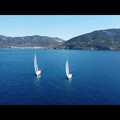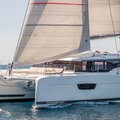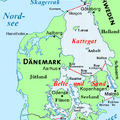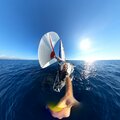Néhány alapszó és alapkifejezés angolul a vitorlázás témában, amit fontos tudni, ha külföldön (tengeren vagy óceánon) vitorlázunk.
What's the origin of nautical terms like "jibe," "tack," etc.?
Matt Craver replies: We don't like to rush things, Steve, so this article won't help with your understanding of the 1999-2000 America’s Cup contest, which was underway when you wrote, or for that matter the recently-concluded 2010 edition. However, we figure we're giving you a big head start on the next cup defense, circa 2020.
I'll discuss the terms you asked about plus a few others. The Dictionary of Nautical Literacy is 432 pages in paperback, so forgive me if I don't give you a complete list.Although the origin of sailing terms isn't always clear, many come from old Dutch, Norse, and Germanic languages. These peoples were accomplished sailors from ancient times, so their impact on the language of sailing in today’s English isn’t surprising.
Let's get the basics out of the way first:
Bow – The front of a boat or ship, deriving from bog in Low German, Dutch and Danish meaning “shoulder or arm.” We still use the derivative form “bough” to mean the limb of a tree. The term was adapted for nautical use in Middle English to refer to the “shoulders” of a boat’s hull.
Stern – The rear of a boat or ship, from the Old Norse stjorn or Old Frisian stiarne, “steering.” The oar used to steer a Norse vessel was usually located at the stern.
Starboard – The right side of the boat as you look toward the bow. From the Old English steorbord, “the side on which the boat is steered.” Equivalents existed in other Germanic languages such as Middle Dutch, Middle High German, Old Icelandic, Swedish and Danish. These peoples used a steering oar mounted on the right side of the stern - see http://tinyurl.com/25vgfen.
Port – The left side of the boat as you look toward the bow. The Old English port means essentially what it does today, “harbor.” Since the steering oar was on the right side, these ships tied up to a dock on the left side.
Next for some sailing directions and maneuvers:
Tack – 1. (noun) The direction of a sailing vessel relative to the wind. If the wind is coming from starboard (your right), you're on a starboard tack. A port tack means the wind is coming from port (your left). 2. (verb) When heading upwind, to change direction so that the wind shifts from one side of the vessel to the other. Both senses come from Old North French tache, “nail, pin,” which may have roots in older German words meaning “pointed thing.” The use of this word to mean “to hold the corner of a sail in place” starts in 1481 and by 1614 it meant “to sail across or diagonally to the wind.”
Jibe – To change direction when heading downwind - that is, when the wind is blowing from behind you. In most modern sailboats, a jibe is a more dangerous maneuver than a tack because the boom can swing violently. The term comes from the Dutch gijben, related to gijk, “boom or spar.”
Beating – “Beating into the wind” or “tacking into the wind” means sailing upwind. No sailing vessel can sail directly into the wind; the closest most modern boats can come is about 45 degrees off the wind direction, although racing boats can get as high as 36 degrees. (Note to sailors: we're speaking of actual wind here, not apparent.) To sail upwind a boat must tack repeatedly, following a zigzag course. In yachting races like the America’s Cup, the course is usually triangular, with one leg directly upwind or close to it. That means beating into the wind, the frequent tacks generally making this the most tactically challenging leg of the race. (Doubtless for that reason, the yachts sail up and down this leg several times.) Since the waves are driven by the wind, the boat's hull pounds or "beats" against them as it slices through the water, hence the term.
Now let’s talk about the parts of a sailing vessel:
Hull – The part of the boat between the deck and the keel that keeps out the water. The origin of this word has more to do with seeds than boats. The Old English hulu, "seed covering," traces back to the Germanic hülle, “covering.” Whether the word was applied to ships because both boat and seed hulls keep out water or because some people thought a ship’s hull looked like a peapod is a matter of speculation. I find this strange because, unlike most of these other words, “hull” entered English late, first turning up in 1551.
Deck – The part of the boat you can stand on. From Middle English dekke and Middle Dutch decke, "roof, covering." Over time the meaning shifted from “what’s over your head” to “what you stand on.” On a vessel with multiple decks, of course, what you stand on covers the heads of those on the deck below.
Keel – Originally this was the main longitudinal beam supporting the rest of the vessel’s framing and therefore the lowest structural element in the hull. Today, it means the portion of the hull projecting downwards to give the craft stability. In Old Norse, the word kjölr, “keel,” came from the proto-Germanic *keluz, an older word of uncertain meaning. Related words include Middle Dutch keil, “ship,” Old English ceol, “ship’s prow,” and Old High German kiel, “ship.” Presumably these similar words affected the understanding of the modern word keel, but the relationship is too muddled to be sure which was first.
Spars – All the booms, masts, yardarms, etc., that support the sails and rigging. Spars used to be wooden but today can also be metal or carbon fiber. The term comes from the Middle Dutch sparre/spaer or Middle Low German sparre/spare, “stout pole” and ultimately from the Indo-European base *sper-, “spear, pole.” Nautical use in the “stout pole” sense dates from 1640.
Mast – A vertical spar to support booms, rigging and sails. In other words, the long pointy thing sticking straight up from the deck. The term started out as the Indo-European *mazdos, “pole, rod,” and evolved into the early Germanic mæst, meaning what it does today.
Boom – A horizontal spar attached to the mast that is in turn attached to the lower edge of a sail. It's from the Scottish boun and earlier the Dutch boom, "tree, pole, beam," which derives from a Middle Dutch word analogous to the English word beam.
Yard or yardarm – A horizontal spar attached to the mast from which a sail hangs. Yards are rare on modern sailboats but a standard feature of square-rigged “tall ships.” The term comes from the Old English gyerd or gierd, “rod, stick,” which was also a measure of length, a sense retained today.
Rigging – All the ropes, chains, cable, etc., that control the sails and spars. “Standing rigging” is fixed and not generally adjusted during a race. “Running rigging” is adjusted frequently to position the sails and yards during the race. The origin of the term is obscure, although Norwegian and Swedish rigga and Danish rigge both mean something like “to bind or wrap up.”
Sheet – A rope used in setting a sail. On most modern sailboats, these haul the boom from one side or the other and set the angle of the boom (and thus the sail) to the wind, which is essential for maximum speed. From the Old English scéatlíne “sheet-line,” a compound of scéata, “lower corner of sail,” originally “piece of cloth.” The meaning had migrated from the sail to the rope used to control it to by the 1300s.
Halyard – A rope used to haul the sail up the mast, from the Old French halier, “haul,” plus “yard” as described above. So a “halyard” was a rope that hauls the yard up the mast. In vessels without yardarms, the word was applied to hauling the sail itself rather than the yard it was attached to.
Main – Also called a mainsail and sometimes pronounced “mains’l,” this is the main triangular sail attached to the mast and boom on most modern sailboats and generally provides most of the power.
Foresail – Often pronounced "fors’l,” any sail that isn’t attached to a boom and flies in front of the mast or masts. On a tall ship, there may be multiple foresails carried before the foremast. On most modern sailboats, there’s usually only one foresail carried in front of the mast.
Jib – A triangular foresail. This is the most common type of foresail, used in most winds. We're not sure where this word comes from, but the Oxford English Dictionary speculates it's a shortening of gibbet, the frame used to suspend a noose for hanging. This is supposedly a reference to the way the top corner of the sail hangs from the masthead.
Spinnaker – A larger, lighter, more balloon-like foresail, used only when the wind is coming from astern. The first yacht to carry such a sail was the Sphinx in 1866, whence the original term “sphinxer.” This quickly shifted to the easier-to-pronounce “spinniker” and became "spinnaker" by 1886.
Genoa – A triangular foresail larger than a jib, overlapping the mast. Used when the wind is coming from just astern of the beam to three-quarters astern. The sail is named for the city in Italy, where such sails were commonly used by small boats.
Gennaker – A foresail that's a cross between a genoa and a spinnaker, hence the name.
— Matt Craver, Straight Dope Science Advisory Board, (Edited by Gfactor)
Jó tanulást és jó szelet! Méder Áron, Ocean Sailing SE (www.oceansailing.meder.hu)




